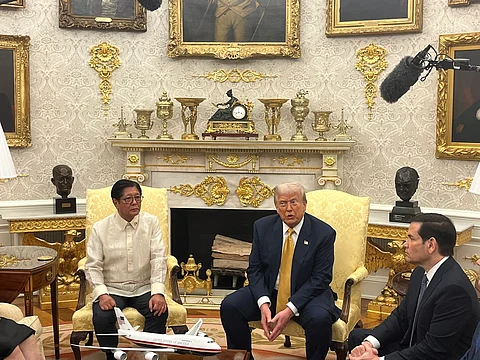
- NEWS
- the EDIT
- COMMENTARY
- BUSINESS
- LIFE
- SHOW
- ACTION
- GLOBAL GOALS
- SNAPS
- DYARYO TIRADA
- MORE

WASHINGTON D.C., United States — President Donald Trump on Tuesday announced a 19 percent tariff on Philippine goods entering the United States, one percentage point down from the previously imposed 20 percent.
“The Philippines is going open market with the United States, and zero tariffs. The Philippines will pay a 19 percent tariff,” Trump made the announcement in a post on Truth Social following his first bilateral meeting with President Ferdinand Marcos Jr., who he hosted at the White House.
The concluded trade deal puts the Philippines at a disadvantage, as certain industries such as automobiles can now enter the Philippine market tariff-free, as confirmed by Marcos himself.
“Now, I think it's – I can already tell everyone, as it’s come out already, that we managed to bring down the 20 percent tariff rate for the Philippines to 19,” he told Filipino journalists at a Kapihan held at the Garden Room, Blair House.
“Now, one percent might seem like a very small concession. However, when you put it into – in real terms, it is a significant achievement. So, we have a 19 percent rate coming from – for imports coming from the Philippines into the United States,” he added.
Marcos said the 1 percentage point reduction in the originally imposed tariff was “because of the special relationship” between the Philippines and the United States.
The tariff reduction, however, was modest compared to the Philippines’ neighboring countries. Indonesia, for example, secured a reduction from 32 percent to 19 percent in certain sectors. Cambodia was able to lower its tariff by 13 percentage points, while Laos received an 8-point cut.
Trump had originally imposed a 17 percent tariff on Philippine goods entering the US in April.
Open market
Marcos, who earned praise from Trump for being a “tough negotiator,” confirmed that the latter asked for certain markets to be opened.
“The one – the major areas that he said were automobiles. Because we have a tariff on American automobiles, we will open that market and no longer charge tariffs on that. So, there's several,” he said.
On the other hand, Marcos noted that Trump agreed on an increased import of American-made soy products and wheat products, adding that medicine importation will also increase.
“So, we are coming to those arrangements. There's still a lot of detail that needs to be worked out on the different products and the different exports and imports,” he said.
“But basically, that's now our template. That's what we are following, is at 19 percent tariff rate on Philippine goods that are imported into the United States,” he added.
‘We tried’
Marcos asserted that he “tried very hard” to negotiate a lower tariff rate for Filipino products but acknowledged that “this is how negotiations go.”
“We came here, when we arrived in Washington, tariff rates were 20. So, why it came up from 17 to 20 is an internal matter with the United States government,” he said when asked whether the trade deal is a disadvantage for the country.
“So, we – but the number that we had to work on was 20. So, we tried very hard to see what we can do. And we managed the one percent decrease in tariff rates,” he added.
Trump earlier cited a deficit of nearly US $5 billion with the Philippines last year on bilateral goods trade of $23.5 billion as the basis of his new tariff rate for its treaty ally.
The Philippines is one of the oldest allies of the United States in the Indo-Pacific region.
